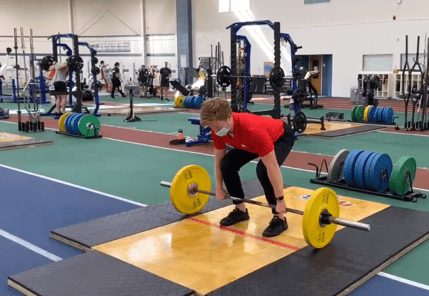 If you are like me, with a busy, on-the-go lifestyle, you probably don't have more than an hour to get inside the gym and train. Lucky for you, that’s okay!
If you are like me, with a busy, on-the-go lifestyle, you probably don't have more than an hour to get inside the gym and train. Lucky for you, that’s okay!
By training with a full-body routine utilizing complexes, you can spend less time in the gym and still see the results. This not only saves you time in the gym, but it also allows for more time with family and friends, all while seeing the results you want. One way to accomplish this is through a barbell or kettlebell complex.
What Is a Complex?
A complex is a series of movements that are performed back to back in which the set number of reps is done for a movement before moving to the next. A complex can be performed with a barbell or one or two kettlebells/dumbbells. Each movement within the complex should flow into the next one. A good way to achieve this is to start from the ground and work your way up.
How to Build a Complex
Any number of reps can be done for each movement. The more movements within the complex, the fewer reps you will want to complete for each one. A complex consisting of four to six movements should be kept at one to five reps per movement. If your complex is only two to three movements, you can use higher reps. Some examples of complexes include the following:
Barbell 1
- Row x 1–5 reps
- Deadlift x 1–5 reps
- Hang Power Clean x 1–5 reps
- Front Squat x 1–5 reps
- Push Press 1–5 reps
Barbell 2
- Deadlift x 3–6 reps
- Clean x 3–6 reps
- Press x 3–6 reps
Kettlebell or Dumbbell 1
- Pushup x 1–5 reps
- Row x 1–5 reps
- DL x 1–5 reps
- Clean or Snatch x 1–5 reps
- Squat x 1–5 reps
- Press x 1–5 reps
Kettlebell or Dumbbell 2
- Pushup x 3–10 reps
- Row x 3–10 reps
- Swing x 3–10 reps
- Squat x 3–10 reps
I recommend completing two to three rounds, but you can also work up to as many rounds as possible with good technique. Within each complex there will be a movement that limits the weight for the entire complex, and it is better to start the first round with a weight you think will be too light.
For example, the movement that will decide your weight in Barbell 1 above is the push press. The deadlift might feel easy, but that is okay. By the end of the complex you will be happy you did not go as heavy as possible. Try to do the entire complex without setting down the weight to rest, and remember to complete all of the reps for one movement before moving on to the next movement.
Why Should I Implement Complexes?
These complexes are an amazing full-body tool that you can use if you are running low on time for your session, or if you have limited days per week you can come in and train. They are also a great way to add additional volume to your workouts, or can even be used as a finisher at the end to build resilience and touch up your conditioning. If your goal is to be better conditioned, adding a sprint or jog component at the end using pieces such as the echo bike, rower, ski-erg, or SPARC trainer can provide a nice cherry on top of an already stellar total-body workout.
Give these complexes a try to get your blood pumping, and let us know how they go! If you need any technique tips or complete workout programs, come visit us at the track desk for more information on what we offer and how to get that set up!
This blog was written by Evan James, NIFS Exercise Physiologist EP-C, Health Fitness Instructor, and Personal Trainer. To learn more about the NIFS bloggers, click here.


 We have all seen people in the gym just walking around carrying weights such as kettlebells, dumbbells, and maybe even sandbags. It may look easy since they are just walking, but carries are a complex exercise that, when you give it a try, you will realize are actually pretty challenging. Don’t knock them until you’ve tried them!
We have all seen people in the gym just walking around carrying weights such as kettlebells, dumbbells, and maybe even sandbags. It may look easy since they are just walking, but carries are a complex exercise that, when you give it a try, you will realize are actually pretty challenging. Don’t knock them until you’ve tried them!